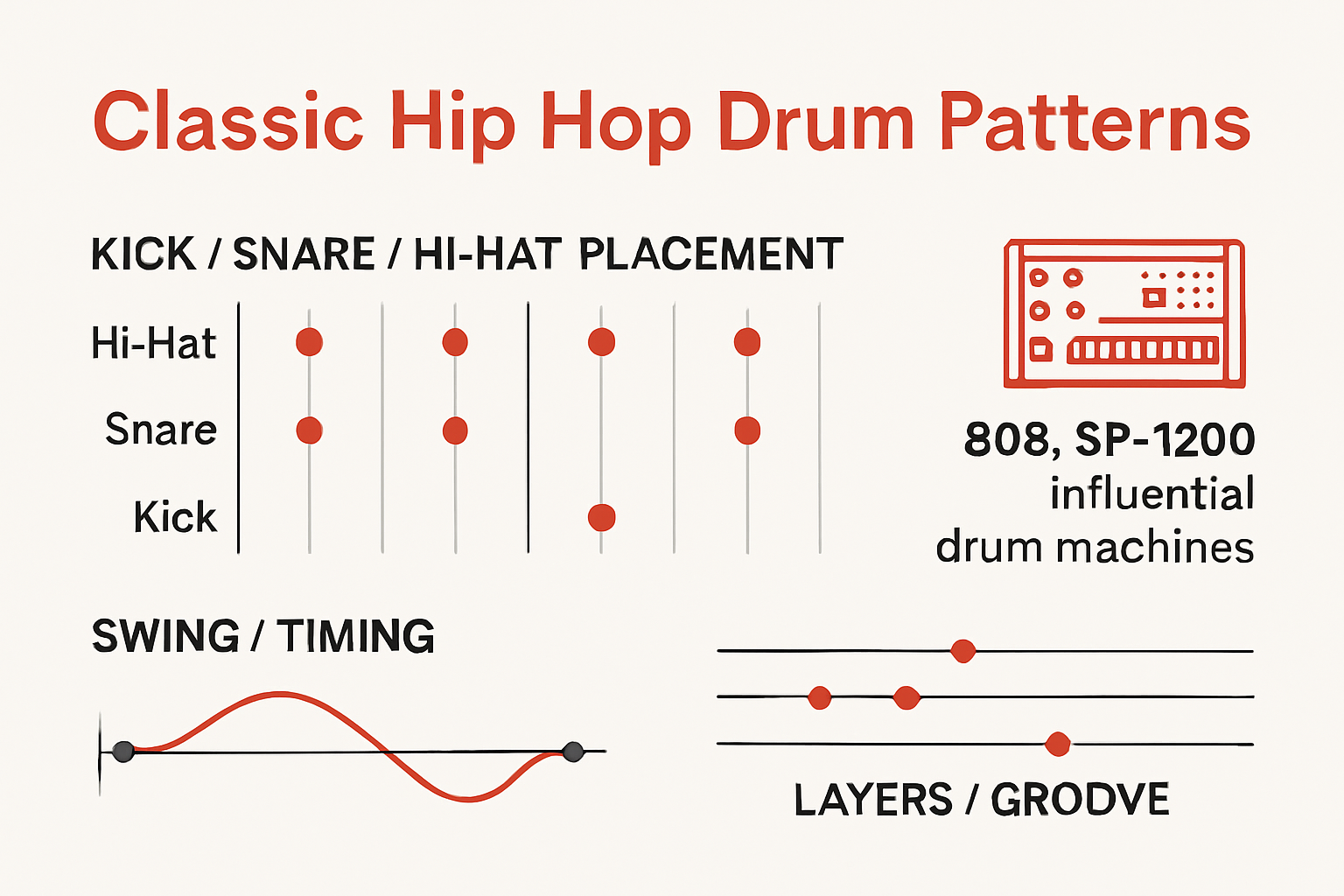Hip hop drum patterns are the backbone of countless iconic tracks and drive the energy behind every great beat. Surprising fact: research shows that even millisecond-level timing tweaks can completely change the groove and feel of a song. Most producers think the magic is all in complex patterns and fancy gear, but the real secret lies in mastering simple rhythms and tiny details that make your beats cut through the noise.
Table of Contents
Quick Summary
| Takeaway | Explanation |
|---|---|
| Choose Quality Drum Sounds | Start with kick, snare, and hi-hat samples that complement each other for a strong foundation. |
| Focus on Timing and Groove | Utilize swing and micro-timing variations to create an organic feel in your beats. |
| Layer for Complexity | Add additional percussion and use EQ and compression to blend sounds seamlessly. |
| Avoid Overcomplicating Patterns | Simple, cohesive drum patterns often yield better results than overly complex arrangements. |
| Experiment with Sound Design | Explore unconventional sound sources and innovative techniques to develop a unique sonic signature. |
Understanding Classic Hip Hop Drum Patterns
Hip hop drum patterns represent the rhythmic backbone of a genre that revolutionized music production. These intricate rhythmic structures go far beyond simple beat-making and serve as the fundamental language of hip hop’s sonic expression.
Enter your text here...

The Rhythmic Foundation of Hip Hop
Classic hip hop drum patterns emerged from a rich cultural landscape of musical innovation. According to research from the Empirical Musicology Review, the microtiming phenomena in hip hop drum performances create unique groove characteristics that distinguish the genre. Producers carefully craft these patterns by layering sounds, manipulating timing, and selecting specific drum samples that capture the essence of hip hop’s rhythmic complexity.
The archetypal hip hop drum pattern typically features a powerful kick drum on the downbeat, complemented by crisp snare hits that create tension and release. These foundational elements are often derived from funk and soul breakbeats, sampled and reconstructed to form entirely new rhythmic landscapes. Research from Popular Music journal highlights how producers manipulate timing and sound selection to achieve the quintessential hip hop groove.
Technical Nuances of Drum Pattern Construction
Professional beat makers understand that creating compelling hip hop drum patterns requires more than just technical skill. It demands an intuitive understanding of rhythm, swing, and musical storytelling. The golden age of hip hop (1986-1996) saw producers developing intricate rhythmic techniques that would define the genre’s sound. As a comprehensive study from Arizona State University reveals, these patterns often correlate with complex rudimental snare drumming techniques, demonstrating the sophisticated musical heritage behind seemingly simple beats.
The construction of these patterns involves strategic placement of percussion elements. Producers typically use drum machines like the Roland TR-808 and sampling techniques to create layers of sound. The kick drum provides the foundational pulse, while hi-hats and snares add complexity and movement. Swing and timing variations are crucial – slight offsets in drum hit placement can transform a rigid beat into a living, breathing musical statement.
While technology has evolved, the core principles of hip hop drum pattern design remain consistent. Modern producers continue to draw inspiration from classic techniques, reimagining rhythmic structures for contemporary audiences. If you’re looking to dive deeper into professional beat creation, check out our guide on crafting professional beats.
Understanding these classic hip hop drum patterns is more than a technical exercise – it’s about capturing a cultural language of rhythm, innovation, and musical expression.
Step-By-Step Guide to Building Beats
Creating compelling hip hop beats requires a strategic approach that blends technical skill with creative intuition. This guide breaks down the essential steps for constructing powerful drum patterns that capture the essence of hip hop’s rhythmic language.
Choosing Your Foundation
Every great beat starts with selecting the right drum sounds. According to Berklee Online, the cornerstone of hip hop drum construction involves carefully curating kick, snare, and hi-hat samples that complement each other. Professional producers recommend spending time exploring different sound libraries and understanding the unique characteristics of each drum sample.
Start by selecting a kick drum with substantial low-end punch. The kick should provide the track’s foundational pulse. Next, choose a snare that cuts through the mix with crisp definition. Hi-hats play a crucial role in adding rhythmic complexity and movement to the beat. hi-hat samples experimenting with layered hi-hat patterns to create depth and variation.
Constructing the Rhythmic Framework
Building a hip hop beat involves strategic drum placement and timing manipulation. ICON Collective recommends establishing a solid tempo first – typically between 85-110 beats per minute for classic hip hop styles. The classic boom-bap pattern typically features a kick on the first and third beats, with snares landing on the second and fourth beats.
Advanced producers focus on swing and timing variations. Slightly offsetting drum hits creates a more organic feel essential to hip hop’s groove. Experiment with subtle timing adjustments on your hi-hats and snares. These micro-timing variations transform a mechanical beat into a living musical expression. Use your digital audio workstation’s quantize and swing functions to add human-like rhythm to your patterns.
Layering and Refinement
The final stage of beat construction involves careful layering and sound design. Consider adding subtle percussion elements like claps, rim shots, or additional percussion to create textural complexity. Compression and equalization help glue the hip hop drum sounds together, ensuring each element sits perfectly in the mix.
Remember that great beats tell a story. Each drum hit should serve a purpose, creating tension and release. Pay attention to the overall groove and how the different elements interact. If you want to take your beat-making skills to the next level, check out our comprehensive beat production course.
Mastering hip hop drum patterns is a journey of continuous learning and creative exploration. Each beat you create is an opportunity to develop your unique sonic signature.
Here is a step-by-step breakdown of the beat-building process to help you structure your production workflow:
| Step | Action | Key Tips |
|---|---|---|
| 1 | Select kick, snare, and hi-hat samples | Choose complementary sounds with distinct character |
| 2 | Establish tempo (usually 85-110 BPM) | Set a groove appropriate for hip hop style |
| 3 | Lay down basic rhythm (kick, snare, hi-hat) | Place kicks on 1 & 3, snares on 2 & 4 |
| 4 | Add swing/micro-timing variations | Use DAW quantize/swing; offset snare/hi-hat hits for groove |
| 5 | Layer additional percussion elements | Claps, rim shots, or extra hi-hats for depth |
| 6 | Mix using EQ and compression | Glue sounds together; ensure clarity in the mix |
| 7 | Refine and arrange beat sections | Craft tension and release; create dynamic interest |
Common Mistakes and Pro Tips for Musicians
Mastering hip hop drum patterns requires more than technical skill – it demands understanding the nuanced pitfalls that can derail even experienced musicians. Recognizing and overcoming common mistakes is crucial for developing a professional-level approach to beat creation.
Technical Execution and Timing Challenges
According to the London Drum Institute, inconsistent timing represents one of the most significant obstacles for emerging musicians. Poor timing disrupts the fundamental groove that defines hip hop’s rhythmic identity. Professional producers recommend practicing with a metronome to develop a rock-solid internal sense of rhythm.
Many musicians overcomplicate their drum patterns, believing complexity equals quality. Research from Melodics suggests that tight, cohesive patterns are far more effective than cluttered arrangements. The key is creating space within the beat, allowing each drum element to breathe and contribute meaningfully to the overall composition.
Dynamics and Emotional Expression
Dynamics represent the soul of hip hop drum patterns. Liberty Park Music emphasizes that neglecting velocity variations can make beats sound mechanical and lifeless. Experienced producers understand that subtle intensity changes create emotional depth. Introduce ghost notes, vary your accent patterns, and experiment with slight timing offsets to inject human-like feel into your beats.
A common mistake is rigidly adhering to quantized grid lines. While precision matters, true hip hop grooves emerge from intentional imperfections. Think of your drum pattern as a living, breathing entity – not a robotic sequence of exact mathematical divisions. Slight human irregularities create the organic swing that defines classic hip hop rhythms.
Professional Workflow and Creative Development
Successful beat makers develop disciplined workflows that balance technical skill with creative exploration. Document your process, study classic tracks, and continuously analyze your own work. Record multiple variations of each beat, allowing yourself creative freedom while maintaining a critical ear.
Remember that mistakes are learning opportunities. Every imperfect beat brings you closer to understanding the nuanced art of rhythm construction. If you’re looking to accelerate your learning, check out our comprehensive beat production resources.
Ultimately, mastering hip hop drum patterns is a journey of continuous improvement. Embrace the process, stay curious, and never stop experimenting with your sound.
The table below summarizes common mistakes and recommended solutions for producers creating hip hop drum patterns:
| Common Mistake | Description | Pro Tip or Solution |
|---|---|---|
| Inconsistent timing | Drum hits not aligning with the beat, causing groove issues | Practice with metronome to develop strong rhythm |
| Overcomplicating patterns | Adding too many layers or hits; beat sounds cluttered | Keep rhythms simple and allow space between elements |
| Lack of velocity variation | Every drum hit has the same intensity; mechanical feel | Use velocity changes and dynamics for human feel |
| Rigid quantization | All notes perfectly on the grid, losing groove | Add slight timing offsets for organic swing |
| Not documenting the workflow | Disorganized sessions and lost creative ideas | Save variations and organize process as you work |
Creative Ideas to Make Your Drums Stand Out
In the competitive world of hip hop production, creating distinctive drum patterns is essential for establishing your unique sonic signature. Standing out requires innovative techniques that push beyond conventional beat-making approaches.
Unconventional Sound Design
Research from the Popular Music journal reveals fascinating techniques for manipulating drum sounds. Producers can create unique textures by layering multiple trap kick drum samples with varying attack characteristics. This approach allows you to construct composite sounds that defy traditional sonic expectations. Experiment with combining unexpected sample sources – try blending electronic drum machine sounds with acoustic recordings or field recordings to generate truly original percussion textures.
Consider exploring non-traditional sound sources. Household objects, industrial noises, or even human-generated sounds can become powerful percussion elements when processed correctly. The key is maintaining rhythmic integrity while introducing unexpected sonic characteristics.
Advanced Timing and Groove Manipulation
According to deep learning research from DeepDrummer, innovative drum loop generation involves actively challenging traditional rhythmic constraints. Modern producers can leverage neural network techniques to explore unconventional groove patterns. By deliberately introducing slight timing variations and unexpected accent points, you can create drum patterns that feel simultaneously familiar and groundbreaking.
One advanced technique involves deliberately recording drum elements slightly off the grid. This approach introduces a human-like imperfection that can make programmed beats feel more organic and dynamic. Pay attention to micro-timing variations – even millisecond-level adjustments can dramatically transform a beat’s emotional character.
Technical Innovation in Drum Tuning
Fascinating research examining producer Scott Storch’s techniques reveals innovative approaches to drum sound design. Some producers transpose entire song arrangements to accommodate a specific drum sound, particularly when working with iconic instruments like the Roland TR-808. This demonstrates a willingness to restructure entire musical compositions around a compelling percussion element.
When designing drums, consider the spectral properties of your sounds beyond traditional pitch considerations. Focus on how different frequency ranges interact, and how subtle modifications can create unique sonic landscapes. If you want to dive deeper into professional drum sound design, check out our expert beat production resources.

Ultimately, making your drums stand out is about fearless experimentation. Trust your creative instincts, challenge conventional wisdom, and never stop exploring the infinite possibilities of rhythmic expression.
Frequently Asked Questions
What are the essential elements of hip hop drum patterns?
The essential elements of hip hop drum patterns include kick drums, snares, and hi-hats. These components work together to create a solid rhythmic foundation and drive the energy of the beat.
How can I improve the timing and groove of my hip hop beats?
To improve timing and groove, utilize swing and micro-timing variations. Slightly offsetting hi-hat and snare placements can create a more organic feel, transforming a mechanical beat into a lively musical expression.
What common mistakes should I avoid when creating hip hop drum patterns?
Common mistakes to avoid include inconsistent timing, overcomplicating patterns, and neglecting dynamics. Focus on keeping rhythms simple, allowing space for each element to breathe, and varying the intensity of drum hits for a more natural sound.
How can I make my hip hop drums sound unique?
To make your hip hop drums stand out, experiment with unconventional sound design, such as layering unexpected samples and manipulating timing. Incorporating non-traditional sound sources can also add originality to your drum patterns.
Take Your Hip Hop Drum Patterns to a Professional Level
Feel like your drum beats sound flat no matter how much you tweak timing and swing? The article showed how mastering small details in your drum patterns can set your music apart in 2025. If you are tired of static-sounding tracks or confused about blending classic groove with modern polish, you are not alone. Producers everywhere face the challenge of building unique drum patterns that actually capture attention.
Ready to move beyond generic loops and unlock your own signature sound? With The Corporatethief Beats you get more than just tips. Explore hands-on beat production resources built upon years of proven industry experience. Find exclusive trap instrumental beats or dive into actionable guides explaining music licensing and beat marketing. Do not wait while the sound of hip hop keeps evolving. Visit The Corporatethief Beats today and start building drum patterns that stand out for all the right reasons.








